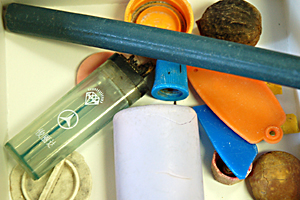It's hard to imagine the scope and breadth of the Great Garbage Patch that lies in the North Pacific Gyre in the Pacific Ocean between the West Coast and Hawaii. It's estimated to be about double the size of Texas. Most people think of it as an island of trash, but that's not accurate. It's floating debris - about 80 percent of it plastic, according to Charles Moore of Algalita Marine Research Foundation - that is caught between ocean currents. And that debris is getting thicker and thicker in the water.
The current flows eastward at the bottom (southern end) of the Gyre, and westward along the top (northern edge) of the Gyre. And another current runs northward right along the West Coast. In the center of all of those currents is the Gyre, and that's where all the debris drifts. It's like the center of a hot tub where bubbles tend to form. Because of all of the garbage in the Gyre, Moore says it’s "like a toilet bowl that never flushes."
So it's not a matter of this giant area getting any bigger. The concern is that the area will become much denser with plastic, given the increasing amount of plastic and other detritus going into our ocean. Plastic doesn't biodegrade, but it does degrade into smaller pieces, and those pieces are making the water in the Gyre a lot thicker and soupier. Right now, Moore says, there are places in the Gyre where plastic bits outnumber plankton 6 to 1.
There are five Gyres in oceans around the world, and data is just starting to be collected on how much trash and plastic are in all of them. Moore pegs the estimated amount of plastic in the North Pacific Gyre at 3 million tons.

